Welcome to Saqqara.nl
This website is maintained by the Friends of Saqqara Foundation, a non-profit foundation aimed at providing financial support for Dutch archaeological research at Saqqara, Egypt. For the last fifteen years the foundation has particularly supported the joint excavation team of the National Museum of Antiquities at Leiden, the Museo Egizio at Turin and Leiden University. For several decades, this team has been advancing the research, documentation, and preservation of the monuments in the area to the south of the Step Pyramid of Djoser, where a cemetery of important New Kingdom officials is located.
If you wish to support the Dutch expedition’s excavations and restorations at Saqqara, make an online donation to the Friends of Saqqara Foundation now!
You can transfer your donation to the bank account of the Friends of Saqqara foundation. Our banks details are as follows:
IBAN: NL18 INGB 0009 5621 50
BIC: INGBNL2A
Want to become a Friend?
There are two membership categories:
- Regular, € 35
- Student, € 17,50
(For members abroad an additional € 5 will be charged for postage)
Digging Diary 4, 6-11 April 2019: Hunting hieroglyphs in their natural habitat
Week four was quite exciting! We finally started investigating the underground chambers of Meryneith’s tomb, and Luca began to create the 3D model. In the meantime, Nico continued to excavate north of Maya’s tomb and found some very exceptional objects. Stefanie finalised her restauration work in the central magazine with Islam. Beside small finds registration, Daniel and Lara finished the reorganisation of the new storage rooms. Last but not least, team member Huw Twiston Davies arrived and gets the word in the current Digging Diary to introduce himself and his work.
It’s one thing to read about the tombs excavated by various missions in the books they have published. But to really get a sense of the layout of texts in the individual tombs, and the relation of the tombs to each other, you really need to see the site in person. This was my main reason for visiting the site. As part of the research project “The Walking Dead at Saqqara: The Making of a Cultural Geography”, I work alongside dig director Lara Weiss, and team member Nico Staring at the University of Leiden. Our project attempts to understand the ways in which individuals and groups adapted to and shaped their environment at Saqqara over time in relation to their religious beliefs. The aim of the project is to build up a fuller picture of the development of religious beliefs at the site of Saqqara over the course of the New Kingdom by examining the religious practices at the site, the adaptation and editing of religious texts in the different tombs at the site, and the development of the necropolis landscape.
This is quite different from more traditional accounts of Egyptian religion, which often emphasise the strength of tradition, and the continuity of practice across time. While it is true that many religious texts, and the religious practices of priests in the temple may have remained largely unchanged, this does not mean that nothing at all changed in religious practice across thousands of years. Texts could be re-edited, adapted, or reinterpreted, or reused for new purposes. Particular religious rites, and particular areas of a temple, tomb, or necropolis, for doing them could rise and fall in popularity. The apparently “static” Egyptian religion in reality was likely continuously changing.
My main purpose here is to put what I’ve read into context, and see what the necropolis is like in person. The publications of the individual tombs are excellent, but inevitably cannot give much sense of what the tombs are really like; the sense of the size of each tomb, and in particular the layout of the tombs in relation to one another. Published maps give some sense of how the tombs are packed together, but on the site itself, it is easier to see that they are, in some cases, literally on top of one another.

Down in the shaft of Meryneith’s tomb. Photo: Lara Weiss.
It is difficult to get a sense of scale from the books published about the tombs. Some scenes, which are shown in highly detailed drawings in the published volumes, are in reality much smaller. Other scenes are larger, and always, the layout and the connections between the different scenes only becomes really clear when standing in the tomb itself. A large part of my time at the site is taken up with exploring the surviving tombs, and either checking texts against the version published, or noting the physical interrelations between the scenes more clearly. This is achieved by photographing the scenes from a distance, so that their place in the tomb, and sometimes in the necropolis more broadly, can be seen. This helps to build up a sense of how the living might have interacted with the reliefs, and how the Book of the Deadin particular is ‘spread’ across the site as a whole.
Sometimes this involves checking for decoration in the subterranean chambers of the tomb. On Sunday, I joined an expedition into the burial chambers beneath the tomb of Meryneith, which have to be accessed using a rope-ladder, through a deep vertical shaft, which is normally sealed with heavy casing-stones. Unfortunately, this did not produce any new decoration for me, though the human remains stored here from previous dig seasons has provided plenty of work for the mission’s osteologist.
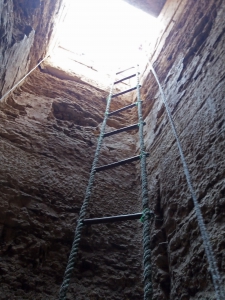
Rope ladder down into the shaft of Meryneith’s tomb. Photo: Lara Weiss.
The most unexpected part of working in the necropolis is the birdsong. A surprising number of birds venture over the escarpment and into the necropolis, presumably to feed on the insects which inhabit the area. In reality, the necropolis is not so far from the cultivation, so it’s not so far for them to fly. We often think of deserts and graveyards as quiet places, but the birdsong is a reminder that ‘quiet’ is a relative term, and in antiquity, it may have been quite different. The sound of funerals in progress, of festival banquets, or the construction of new tombs, all would have made the necropolis quite noisy.
My other chief occupation on-site is to help to read the hieroglyphic and hieratic texts that are excavated, though until the last few days these have been thin on the ground. An offering-table, probably dating to the Late Period and found before I arrived is very difficult to read. In theory, hieroglyphs are quite easy to identify and therefore to read, but after millennia of weather erosion, the forms are often very abraded, and difficult to see on the stone. Sometimes it can be difficult to tell what is dirt, and what is the line of a hieroglyph, or whether a given nick in the stone is part of a sign, or a piece of damage. Sometimes, the eye plays tricks, too, and ‘completes’ a piece of damage, so that you see a hieroglyph where there isn’t one in reality. Reading in these cases often involves the use of a torch, and moving the light repeatedly to try and detect where there are really incisions in the stone. If the text is particularly badly worn, as it is in this case, reconstructing the text can take several attempts, and having several people work on the problem can help to speed up the process of reading.

Daniel and Huw deciphering the inscription on an offering table. Photo: Lara Weiss.
Other inscribed material presents different problems. A fragment of papyrus which was excavated on Monday aroused excitement with the red border visible even when the piece was folded up. This is a fairly common feature in the more elaborate copies of the Book of the Dead, and so might have indicated one of these papyri. In fact, the papyrus is more interesting, but also more puzzling, than this suggested. The remains of the text is very fragmentary. Only two hieroglyphs can be read: one is the number 5, and the other reads ‘i’. The ‘i’ appears at the bottom of the fragment, in what may once have been a single line of text at the bottom of the page, or register. Above it, after a long gap in which everything except the border is missing, appears to be at least one box, with an illustration in it, next to which the number 5 is written. Only a few lines of the illustration remain, so what it depicts is difficult to say.
The format of the papyrus, with a series of boxes containing illustrations, and a line of text boxed in at the bottom, is similar to certain types of papyrus known from the Late Period (c. 664-332 BCE). I thought particularly of the ‘Tanis Geographical Papyrus’ in the British Museum, and our working theory is that the papyrus is some kind of compendium, or “knowledge document” similar to this.
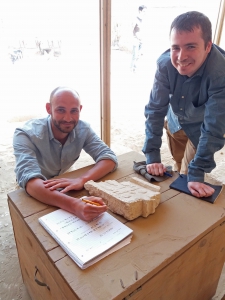
Daniel and Huw in their field office. Photo: Lara Weiss.
But every day on-site is different, and brings new finds and new challenges. Almost anything might emerge from the excavation next. In the meantime, I have many more beautiful reliefs and hieroglyphic texts to examine.
Huw Twiston Davies
Digging Diary 3, 30 March-5 April 2019: Recording in 3D
The third week of our excavations were relatively eventless, as we are still digging through the debris of the 1980s to reach the level of the new tomb discovered in 2018. Without removing the sands first, it would not be safe to work there – the sands would fall down on our staff. While Nico and Paolo are further excavating the area together with the Egyptian workmen, the others gained extra time to reorganize the existing storage spaces. The Polimi team (the 3D Survey Group) continued to survey the greater concession area. The fantastic results are described in this week’s digging diary.
The 3DSurveyGroup of the ABC Department, Politecnico di Milano joined for the second year the Leiden-Turin excavation. The research group, headed by Professor Francesco Fassi and Professor Cristiana Achille, is active in the field of 3D survey, modelling and valorisation of Cultural Heritage. The main activities are: architectural and archaeological survey, monitoring, high resolution and detailed 3D models management, teaching and training.
This season, the team consists of Alessandro Mandelli and Luca Perfetti, with the external collaboration of Professor Corinna Rossi. They are in charge of recording in 3D the entire excavation process, ranging from the whole area of the concession, to the contexts and the small finds that come up during the digging activities.
Within the dualism technology-human sciences, the role of the 3DSurveyGroup is to put metrology at service of the experts in the team, of the public, as well as of future memory. The group’s mission is to join forces with all the team members to maximize data recording before the progress of the excavation destroys the archaeological contexts. The aim is twofold: to increase the subsequent study potential when the mission ends, and to record and disseminate information on the actual context of the finds, that is usually lost.

Alessandro and Luca surveying the excavation area. Photo: Nicola Dell’Aquila.
The 3D models of the excavated area are useful tools to help the work of the archaeologists during and after the excavations. In fact, thanks to these products, they can track the history and the progress of the work and they are able to “travel” back in time, revisiting forever lost contexts from the very first to the last day of the season.
Using such a tool, the archaeologists, back in their offices in Leiden and Turin, can surf the raw, unbiased data from the excavation days, searching for missing information they lost track of, or seeking the answer to unforeseen questions.
When the digging team find something interesting, such as reliefs, pottery and burials the survey team immediately records the situation by acquiring photos and measuring the coordinates of the findings. Later, they improve the first survey, according to the requests, and deliver to each expert what they need.
The Politecnico team provided high-resolution orthophotos that were used to outline some inscriptions engraved in the stone. If the orthophoto is not clear enough, using a normal laptop archaeologists are able to simulate lights moving around the object and illuminate it in various ways, to better understand the signs and drawings. This represents a successful example of collaboration between technical and humanistic sides, in which the former identifies the most efficient tool to answer the questions posed by the latter.

3D model of Find No. 92 with artificial light. Elaboration: Luca Perfetti and Alessandro Mandelli.
All the digital models are collected together in a sort of three-dimensional database, each one in their relative position. This is possible thanks to the topographic network around the excavation area that was checked by the survey team during the very first days of the mission.
During the second week, due to the expansion of the excavation area, they placed and precisely measured a new topographic point in front of Maya’s tomb, and the workers removed the old one.
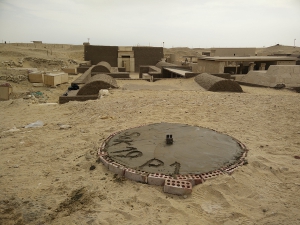
New topographic point SAK19P1. Photo: Alessandro Mandelli.
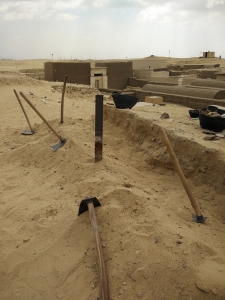
Old topographic point M005. Photo: Alessandro Mandelli.
This year, the team is going to face many challenges: 1) generate the DSM (Digital Surface Model) of the whole concession; 2) complete the 3D models of the main tombs; 3) survey Meryneith’s underground chambers.
After a long walk in the concession using fish-eye lenses to create more than 1.500 photos, the digital model of the concession is nearly concluded. This kind of representation, with the contour lines, helps to understand the topology of the area and the landscape around the main tombs.

Digital Surface Model of the Leiden-Turin concession at Saqqara. Elaboration: Luca Perfetti.
Last year, the team performed a complete survey of the tombs of Maya and Tia and then delivered accurate digital models of the tombs and their reliefs, kindly sponsored by the Friends of Saqqara Foundation. This year the aim is to collect all the data to reproduce also the tombs of Horemheb, Pay, Ptahemwia and Meryneith. Right in these days, the surveys are quite finished and the elaboration is going on.

3D model of Maya’s tomb, kindly sponsored by the Friends of Saqqara Foundation in 2018. Elaboration: Alessandro Mandelli.

3D model of Maya’s tomb: detail of reliefs. Elaboration: Alessandro Mandelli.
Regarding the survey of Meryneith’s shaft and its underground chambers, our PhD student Luca is eager to test a time-effective and low-cost photogrammetric device to survey narrow spaces together with elaboration methodology to guarantee accuracy. The aim is to tailor this technique to cope with the many challenges of surveying this kind of spaces like the tightness of the environment, the absence of any sort of natural illumination and the mazy, meandering architecture. Last year, the team faced a similar situation, when they surveyed a shaft in front of one of the Ramesside chapels in the north area.

Technical drawing of Shaft 131 (season 2018). Elaboration: Luca Perfetti.
In the next days, when the shaft will be opened, they are going to construct a test to compare different approaches and techniques and check for final accuracy.
If you want to know more… stay tuned with the Leiden-Turin Expedition to Saqqara!
Alessandro Mandelli and Luca Perfetti
Digging Diary 2, 23-29 March 2019: Working in a conservator’s paradise
In 2018, the Leiden-Turin Expedition to Saqqara agreed with the Egyptian authorities at Saqqara that we should invest more in both the restauration and consolidation of our shared heritage stored at the central Saqqara magazine, as well as of newly excavated material. The plan is to invite at least one conservator specialized on a specific kind of material to the excavation every season. This season we started with a stone conservator, and so we would like to give the word to Stefanie Papenheim in this week’s digging diary to introduce herself and her work.
My name is Stefanie and I arrived in Cairo on the 21st of March to join the Leiden-Turin team, supporting them to preserve the archaeological stone finds of this season.

Stephanie Papenheim and Islam Taha. Photo: Lara Weiss.
I studied conservation and restoration at the University of Applied Science Erfurt (Germany) and I’m specialized in the treatment of stone and wall-paintings. Since 2014, I work at a private restauration company in Weimar with a focus on the conservation and restoration of stone sculptures and historic gypsum busts from museum collections.
I am very happy to be here, as it is in fact not the first time that I had the chance to work on amazing Egyptian artefacts from Saqqara. In 2015, I supported the Leiden Museum to preserve and restore some of their most famous exhibits, for example the limestone tomb statues of Maya and Meryt.
During the first two days on the excavation site I got a first overview of the latest findings, the material and the condition of preservation. Most of the objects in the storage are impressive reliefs made from limestone with fragments of polychrome colour. They show damage typical for limestone such as flaking, powdering, cracking or exogenous and endogenous deposition like firmly adhering crusts from mud, sand and salts.
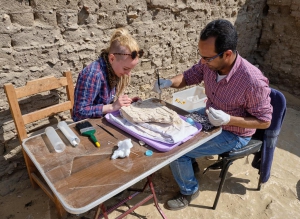
Working on an offering table found this season. Photo: Nicola Dell’Aquila.
In general these kinds of damage are caused by salinization combined with high changes in temperature and relative air humidity or water infiltration. This means that the main conservation work focuses on the reduction of deposition and structurally damaging salts, and on the stabilization of the limestone by consolidating it. All surfaces have to be cleaned carefully with soft brushes and if necessary with a mixture of water and alcohol. During all interventions it is important to reduce the water input to a minimum to avoid the solution and transportation of salts. In some cases a salt reduction with a desalination compress is necessary. Scalings and cracks have to be glued and backfilled. Surface completions of scalings and cracks have to be applied to stabilize the fine and skilfully carved relief. The fragile and flaking fragments of colour on the polished relief surfaces of course require a lot of patience and a very sensitive treatment to fix them.

Our office in the tomb of Maya. Photo: Nicola Dell’Aquila.
In my work, I am supported by Islam Taha, conservator in the Ministry of Antiquities and student of Architecture Preservation and Rehabilitation of Heritage Buildings at Cairo University. We enjoy the team work and it’s very nice to exchange our experiences. We are very much looking forward to working together on various sculptures and reliefs on the excavation site and in the magazines in the upcoming two weeks. We are happy to help preserving them for the future!
Stefanie Papenheim
Digging Diary 1, 17-22 March 2019: Arrival in Saqqara
It’s on! This year’s excavation campaign (17 March to 24 April) started far more comfortable than we are used to. Because of the frequent travels to Egypt in the scope of our new EU project with the Egyptian Museum in Cairo we were able to negotiate a nice deal with a hotel in Zamalek that we are also allowed to use for our travel to the excavation. This is nice, because we have now a big team where we can all be together. On Friday 15 March, the whole team could therefore share a delicious breakfast buffet with Nile view! After some shopping we were ready to go to Saqqara. Our Saqqara driver Hassan Yusef came to pick us up in his Peugeot and Moshir Tawfik, the driver of NVIC, came as well with two cars to get the total of 13 team members and all our equipment to the dig house.

Driving to Saqqara. Photo: Nicola Dell’Aquila.
Atef Sayed Ramadan, our cook, had already arranged for our equipment such as books and mosquito nets to be moved to the house from the Saqqara storage. So, we could unpack immediately upon our arrival. The next day, Saturday 16 March, the team went on a field trip to the Imhotep site museum, the Serapeum, the Djoser complex, and the tombs of Maia and Nemtymes in the Bubasteion area.
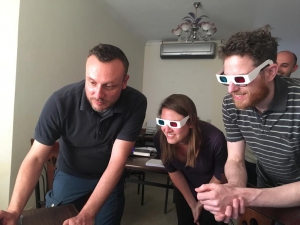
From left to right: Deputy field director Paolo Del Vesco, and Leiden University Archaeologists Miriam Müller and Nico Staring looking at a new 3D model of our excavation area kindly made by the 3D Survey Group / Politecnico di Milano. Photo: Luca Perfetti.
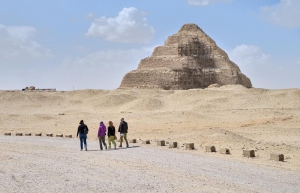
From left to right: Field director Lara Weiss, Archaeologist Miriam Müller, Pottery specialist Valentina Gasparini, and Epigrapher Daniel Soliman walking to the pyramid complex of Djoser. Photo: Nicola Dell’Aquila.
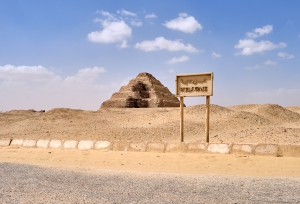
Welcome to Saqqara. Photo: Nicola Dell’Aquila.
On Sunday 17 March, we opened the site and started working. Important to know for our friends and colleagues is a new regulation by the Supreme Council of Antiquities (SCA), that limits our opportunity to receive visitors, as they now have to be approved by an official letter by the Head of the SCA, Mostafa Waziri. We are therefore obliged to kindly ask you not to visit our excavation area this season to avoid difficulties.
The plans for this season’s work are exciting. We will continue to work in the area north of the tomb of Maya and explore and excavate the entrance to the new large tomb we found in 2018.
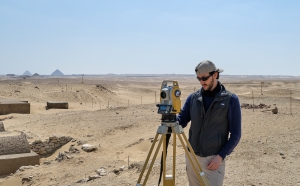
Luca Perfetti surveying the site. Photo: Nicola Dell’Aquila.
In addition, PhD student Luca Perfetti, a member of the 3D Survey Group, will survey the underground chambers of the Early Dynastic tomb that is situated underneath of the tomb of Meryneith. These subterranean rooms were already discovered at the time of excavation of the tomb of Meryneith (c. 1325 BC), but with the new methodology we hope to get even better analysis results of the space to be published soon by Ilona Regulski. In addition, the 3D Survey Group started a new survey of the tomb of Horemheb.

Valentina Gasparini, Alice Salvador and a few workmen in the tomb of Horemheb. Photo: Nicola Dell’Aquila.

Part of the team in front of the pyramid of Djoser. Photo: Nicola Dell’Aquila.
Work is also continuing on material from previous seasons, including small finds, pottery and skeletal material. Osteologist Ali Jelene Scheers studies the child burials we found last year, and Pottery specialists Valentina Gasperini and Alice Salvador keep up with the pottery found in 2018 and continue with the creation of their new typology.
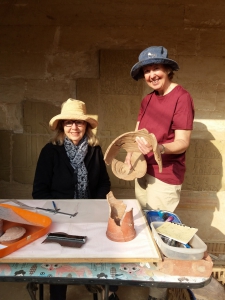
Lyla Pinch-Brock and Barbara Aston working on the pottery from the area south of the tomb of Meryneith.
Last but not least, Barbara Aston and Lyla Pinch Brock will hopefully finalize the pottery for Maarten Raven’s publication of the area of the so-called Five Tombs (forthcoming in the PALMA Series with Sidestone).
In this first week we continued to remove the debris of earlier excavations in the area north of Maya in order to remove the sands and be able to excavate further the tomb that was discovered last season. Beside several small shabti figurines and secondary deposits of burial materials, several objects were found among which a piece of Greek or Coptic papyrus and a small inscribed offering table.
Now we will relax a little bit and catch up on sleep, and very much look forward to continue digging on Saturday!
Lara Weiss
The 2019 Leiden-Turin excavations at Saqqara have started!

A workman gently sifting the sand.
This week the team members from the National Museum of Antiquities, Leiden, the Egyptian Museum in Turin and the Politecnico di Milano arrived in Saqqara.
The mission’s excavation season starts Sunday 17 March and ends Wednesday 24 April.
The first Digging Diary of 2019 is expected to go online on 22 March!
Visit our website every week for the latest Digging Diary of the 2019 fieldwork season!
Renew Your Membership 2019
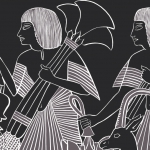 If you wish (to continue) to support archaeological research in Saqqara through the Friends of Saqqara Foundation in 2019, we kindly request you to transfer your 2019 donation into bank account number NL18INGB0009562150 of the Friends of Saqqara Foundation, stating “Donation 2019” and your Friends-number.
If you wish (to continue) to support archaeological research in Saqqara through the Friends of Saqqara Foundation in 2019, we kindly request you to transfer your 2019 donation into bank account number NL18INGB0009562150 of the Friends of Saqqara Foundation, stating “Donation 2019” and your Friends-number.
Your continued support, financially and otherwise, remains a necessity for achieving the objectives of the Foundation.
We thank you for the trust you have placed in us.
The proposed minimum donations are, as in previous years, as follows:
- standard: € 35.00 (€ 40.00 for members living abroad)*
- student: € 17.50 (€ 22.50 for student members living abroad)*
Of course, higher donations are also welcome!
After receiving your donation, you will be marked as a member for the calendar year 2019, with the associated privileges: no entrance fee for the Saqqara Day in June (held in Leiden), discounts on publications sponsored by Friends of Saqqara and you will receive our exclusive Saqqara Newsletter (printed in English) in the autumn.
*An additional € 5 will be charged for shipping outside the Netherlands)
